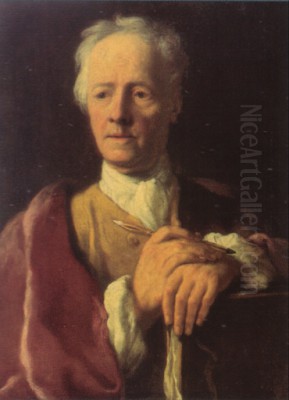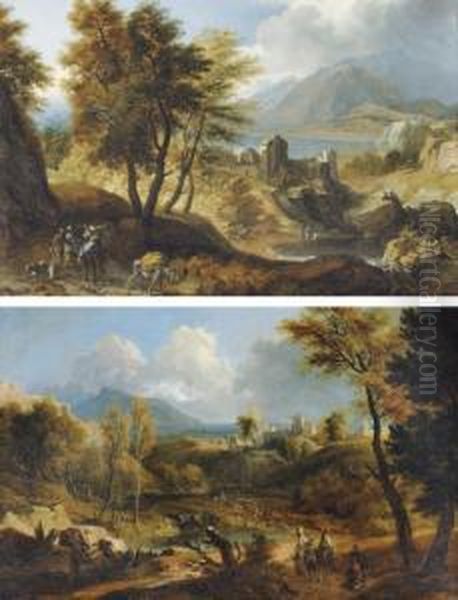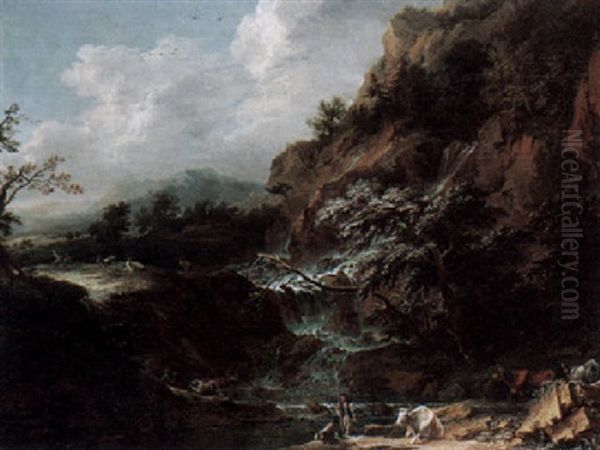
Joachim Franz Beich (1665-1748) stands as a significant, if sometimes overlooked, figure in the landscape of German Baroque art. Active primarily in Bavaria, Beich distinguished himself as a versatile painter of evocative landscapes, dramatic battle scenes, and a skilled etcher. His career unfolded during a vibrant period of artistic production in Southern Germany, heavily influenced by Italian and French artistic currents, yet developing its own distinct regional character. Beich’s work, patronized by the highest echelons of Bavarian society, reflects both these international trends and the specific tastes of his patrons, leaving behind a legacy that merits closer examination.
Early Life and Artistic Formation
Born on October 15, 1665, in Ravensburg, a town in Upper Swabia (then part of the Holy Roman Empire, now in Baden-Württemberg, Germany), Joachim Franz Beich was initiated into the world of art by his father, Daniel Beich. Daniel was himself a painter, providing his son with foundational training in the techniques and traditions of the craft. This familial introduction to art was common during the period, with workshops often passed down through generations. While details of his earliest works are scarce, it is presumed that his initial style was shaped by the prevailing late Baroque aesthetics of Southern Germany, which often blended local traditions with influences filtering in from Italy and the Netherlands.
The artistic environment of Southern Germany in the late 17th century was one of reconstruction and burgeoning cultural ambition following the devastations of the Thirty Years' War. Artists like Johann Heinrich Schönfeld, who had spent considerable time in Italy, brought back a more dynamic and colorful style that influenced a generation. While Beich was younger, the echoes of such Italianate influences would have been part of the artistic air he breathed. His early development under his father would have equipped him with the necessary skills in drawing, composition, and paint handling, preparing him for a career that would eventually lead him to the heart of Bavarian courtly life.
The Italian Sojourn: A Crucible of Influence

A pivotal experience for many Northern European artists of the Baroque era was a journey to Italy, and Beich was no exception. While the exact dates of his Italian travels are not precisely documented in all sources, it is widely accepted that he spent time there, absorbing the artistic lessons of the Italian masters and the visual splendor of the Italian landscape. This period was crucial in refining his style, particularly in landscape painting. Italy, with its classical ruins, sun-drenched countryside, and the legacy of Renaissance and Baroque masters, offered an unparalleled open-air academy.
During his time in Italy, Beich is known to have visited regions famed for their picturesque beauty, including Tivoli, near Rome, renowned for its waterfalls and ancient villas. He diligently filled sketchbooks with studies from nature and observations of architectural motifs. These sketches would later serve as valuable source material for his studio paintings. The impact of Italian art on Beich is most evident in his landscape compositions, which often echo the idealized and structured beauty found in the works of French artists active in Rome, most notably Gaspard Dughet (also known as Gaspard Poussin). Dughet, brother-in-law to the great Nicolas Poussin, specialized in classical landscapes that emphasized harmony, order, and a certain Arcadian tranquility. Beich’s adoption of similar compositional strategies and atmospheric effects suggests a careful study of Dughet’s oeuvre, and perhaps also that of Claude Lorrain, another French master of the idealized Italian landscape whose works were highly influential throughout Europe.
The experience in Italy provided Beich with a sophisticated visual vocabulary. He learned to construct landscapes that were not merely topographical records but poetic evocations, often imbued with a sense of timelessness. This Italianate polish would prove highly appealing to his future patrons in Bavaria. He returned from Italy not just with sketches, but with a matured artistic vision that would define much of his subsequent career.
Court Painter to Maximilian II Emanuel of Bavaria
Upon his return from Italy, or perhaps facilitated by his growing reputation, Joachim Franz Beich found favor with one of the most significant patrons in the Holy Roman Empire: Maximilian II Emanuel, Elector of Bavaria. Max Emanuel was an ambitious ruler with a keen interest in the arts, seeking to emulate the grandeur of courts like that of Louis XIV of France. He was also a prominent military commander, deeply involved in the Great Turkish War. Beich was appointed as a court painter, a position that provided him with prestige, financial stability, and significant commissions.

A substantial part of Beich’s work for Max Emanuel involved documenting the Elector's military campaigns, particularly those in Hungary against the Ottoman Empire. These battle paintings were not simply reportage; they were grand, often propagandistic, depictions intended to glorify the Elector's military prowess and leadership. Beich excelled in this genre, creating large-scale canvases filled with the drama and dynamism of warfare – cavalry charges, sieges, and sprawling battlefields. Works depicting events like the Siege of Belgrade or other engagements in the Hungarian theatre were housed in the Elector's palaces, notably Schleissheim Palace and the Munich Residenz. These paintings required a skillful handling of complex compositions, numerous figures, and the accurate depiction of military uniforms and equipment, all while conveying a sense of heroic action.
His battle scenes can be seen in the context of a broader European tradition of military painting, which included artists like Jacques Courtois (Le Bourguignon), who specialized in such scenes in Italy, and Adam Frans van der Meulen, who documented the campaigns of Louis XIV. Beich’s contributions placed him among the leading German practitioners of this genre.
Master of the Landscape
While his battle scenes were important official commissions, Beich’s enduring reputation also rests significantly on his landscape paintings. Influenced by his Italian experiences and the works of artists like Gaspard Dughet, Beich developed a distinctive style of landscape that blended idealized beauty with a keen observation of nature. His landscapes are often characterized by carefully structured compositions, a harmonious balance of elements, and a subtle rendering of light and atmosphere. They frequently feature rolling hills, tranquil bodies of water, picturesque trees, and often include small figures of peasants, shepherds, or travelers, which add a sense of scale and human presence without dominating the scene.
His work Landscape with Shepherds before a Wide Vista exemplifies this approach, showcasing a serene, expansive view that invites contemplation. The influence of Dughet is apparent in the ordered arrangement of pictorial planes and the classical feel of the scenery. However, Beich’s landscapes also possess a certain Northern European sensibility, perhaps a slightly cooler palette or a more specific rendering of foliage compared to some of his Italianate counterparts. He was adept at capturing the varied moods of nature, from sunlit pastoral scenes to more dramatic, cloud-swept vistas.
Beyond the grand, idealized landscapes, Beich also depicted more specific locales and scenes with rural elements, such as landscapes with windmills and peasants, indicating an interest in the everyday life of the countryside. These works connect to a broader tradition of genre landscape painting popular across Europe, seen in the works of Dutch artists like Jan van Goyen or Meindert Habbema, though Beich’s style remained more rooted in the Italianate classical tradition. His ability to create pleasing and harmonious compositions made his landscapes highly sought after for the decoration of palaces and aristocratic residences.
Beich as an Etcher
Joachim Franz Beich was not only a painter but also a proficient etcher. Etching, a printmaking technique that allowed for greater freedom and spontaneity of line compared to engraving, was a medium favored by many painters for disseminating their compositions or exploring artistic ideas. Beich produced a number of etchings, primarily landscapes, which further demonstrate his skill in composition and his sensitivity to natural forms.
Among his notable works in this medium is the series of six landscape etchings, one of which is Two Goats on a Shore of Lake (circa 1720). This piece, like others in the series, showcases his ability to translate the atmospheric qualities of his paintings into the linear medium of etching. His etched lines are often delicate and precise, effectively rendering foliage, water, and distant terrain. He also produced a series of 26 plates depicting architecture and figures, indicating a broader range of subject matter in his graphic work.
His etchings would have been more accessible to a wider audience than his unique paintings, contributing to the spread of his artistic style. In the realm of etching, he followed in the footsteps of artists like Rembrandt van Rijn, whose landscape etchings were revolutionary, and Jacques Callot, known for his detailed prints of various subjects including battles. While Beich’s graphic oeuvre may not be as extensive or groundbreaking as these masters, his etchings are accomplished works that complement his painted output and highlight his versatility. His work The Waterfalls at Tivoli also exists as an etching, capturing the dramatic cascade that had fascinated artists for centuries, from Maerten van Heemskerck to later Romantic painters.
Notable Works and Artistic Style
Several key works define Joachim Franz Beich's contribution to art history:
Battle Scenes from the Hungarian Campaigns: A series of large paintings commissioned by Max Emanuel, depicting specific engagements. These are characterized by dynamic compositions, a multitude of figures, and a focus on the Elector's central role. Examples include depictions of the Siege of Mainz and various battles in Hungary. These works are primarily housed in Bavarian state collections, such as the Schleissheim Palace.
Landscape with Shepherds before a Wide Vista: This painting is representative of his idealized landscapes, showing a serene, expansive view with classical overtones, reminiscent of Gaspard Dughet.
Two Goats on a Shore of Lake (etching, c. 1720): Part of a series of landscape etchings, this work demonstrates his skill in the graphic arts, capturing a tranquil scene with delicate linework.
The Waterfalls at Tivoli: Existing in both painted and etched versions, this subject highlights his Italian influence and his interest in dramatic natural scenery.
Landscapes with Peasants and Windmills: These works show a different facet of his landscape art, focusing on more rustic, everyday scenes, though still composed with Baroque elegance.
The Sermon of St. John the Baptist: This work indicates his engagement with religious themes within a landscape setting, a common practice in Baroque art, seen in the works of artists from Annibale Carracci to Claude Lorrain.
Beich's overall artistic style can be described as firmly rooted in the Baroque tradition, with a particular leaning towards its more classical and ordered manifestations, especially in his landscapes. His palette is generally rich but controlled, and his compositions are carefully balanced. The influence of Gaspard Dughet is paramount in his landscape work, but one can also see an awareness of the broader Italian and French landscape traditions. In his battle scenes, there is a greater dynamism and complexity, fitting the subject matter, aligning him with other European specialists in this field. He successfully adapted these international influences to the tastes and requirements of his Bavarian patrons.
Contemporaries and Artistic Context
To fully appreciate Beich's position, it's important to consider his contemporaries. In Bavaria, the artistic scene was vibrant. The Asam brothers, Cosmas Damian Asam (painter) and Egid Quirin Asam (sculptor and stuccoist), were creating spectacular illusionistic frescoes and opulent church interiors. Johann Baptist Zimmermann was another key figure, renowned for his stucco work and frescoes, active at Nymphenburg Palace around the same time as Beich. While Beich’s focus was primarily on easel painting and etching, he operated within this rich milieu of Bavarian Baroque and Rococo artistry.
Internationally, the landscape tradition was diverse. In Italy, besides Dughet, artists like Salvator Rosa offered a wilder, more romantic vision of nature, while Andrea Locatelli and Jan Frans van Bloemen (Orizzonte) continued the classical and pastoral traditions in Rome. In France, Jean-Antoine Watteau was ushering in the Rococo with his fêtes galantes, often set in park-like landscapes, while in the Netherlands, the legacy of 17th-century masters like Jacob van Ruisdael continued to influence landscape painting. Beich’s work, therefore, can be seen as a German contribution to this broader European conversation about the depiction of nature and historical events. His patrons, like Max Emanuel, were internationally aware and would have expected a level of sophistication comparable to that found in other European courts.
Later Years and Legacy
Joachim Franz Beich continued to work for the Bavarian court and other patrons throughout his career. He resided primarily in Munich, the center of Bavarian artistic life. His dedication to his craft is evident in the consistent quality of his output over several decades. He passed away in Munich on October 16, 1748, at the advanced age of 83.
His works are primarily preserved in German collections, particularly in Munich at the Alte Pinakothek, the Bavarian National Museum, and Schleissheim Palace. While he may not have achieved the widespread international fame of some of his Italian or French contemporaries like Giovanni Paolo Panini or François Boucher, Beich holds a secure place as one of the leading German painters of his generation, especially in the genres of landscape and battle painting. He successfully synthesized Italianate influences with German sensibilities, serving his patrons with skill and artistry. His paintings and etchings provide valuable insights into the courtly culture and artistic tastes of Baroque Bavaria.
His influence on subsequent German landscape painters is more subtle, as the art world moved towards Rococo and then Neoclassicism. However, his dedication to the careful observation and harmonious depiction of nature, as well as his skilled chronicling of historical events, ensured his lasting significance within the German Baroque tradition. Artists like Christian Wilhelm Ernst Dietrich, later in the 18th century, would also look to various past masters, and the kind of idealized landscape Beich practiced remained a point of reference.
Conclusion: An Accomplished Bavarian Baroque Master
Joachim Franz Beich was an artist of considerable talent and versatility. As a court painter, he fulfilled the demands for grand battle scenes that celebrated the military achievements of his patron, Maximilian II Emanuel. As a landscape painter, he created serene and idealized visions of nature, deeply influenced by his Italian experiences and the classical tradition. His skills as an etcher further broadened his artistic reach. While perhaps not an innovator on the scale of a Rembrandt or a Claude Lorrain, Beich was a master craftsman who absorbed the leading artistic currents of his time and adapted them with skill and sensitivity. His work remains a testament to the richness of Baroque art in Bavaria and an important contribution to the European tradition of landscape and historical painting. His paintings and prints continue to be appreciated for their compositional harmony, technical proficiency, and their evocative portrayal of both the natural world and the dramatic events of human history.